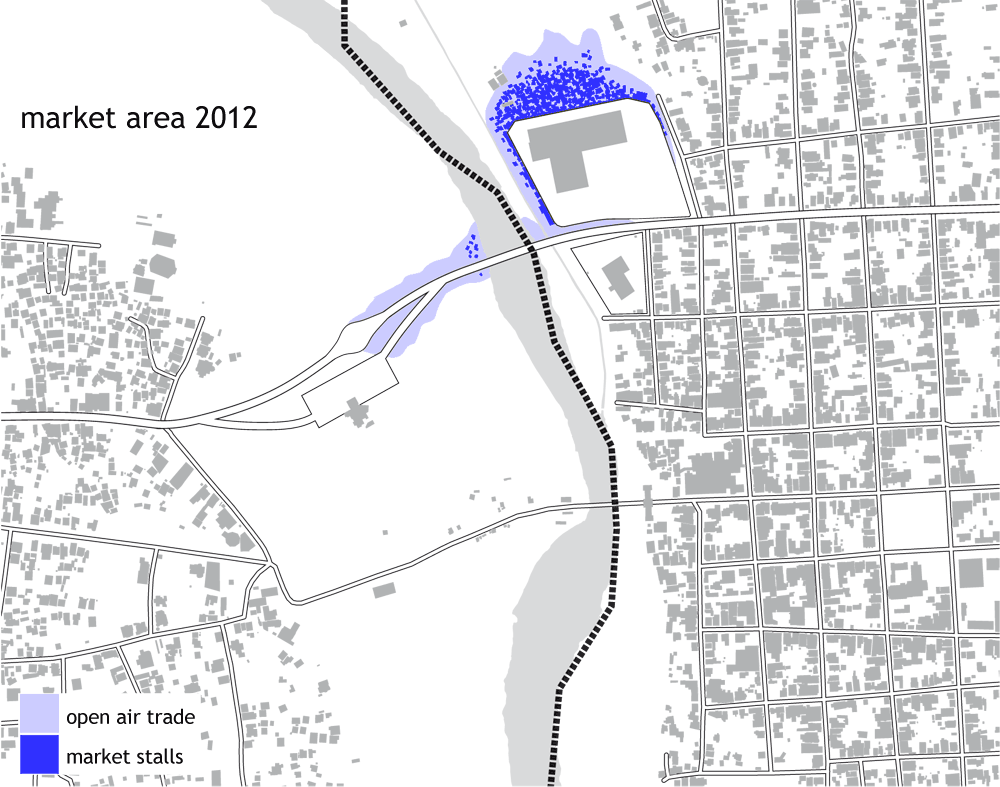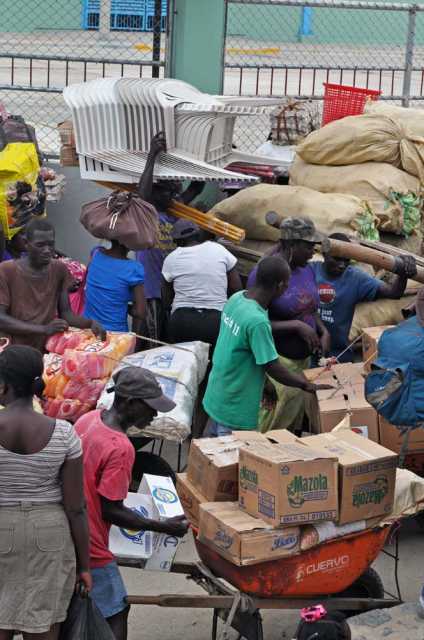

returning with goods from the informal market at the back of the building
Until the cholera scare of 2010 the ‘international fair’ in Dajabón occupied the streets of the town spreading across nine blocks of the centre


The market has now been moved to the new border crossing with vendors initially setting up stall on the fields at the back of the new market hall
Market at the back of the new market hall




spreading into adjoining wood land
Trade along the perimeter of the new market hall


Informal market infrastructure




Goods are carried across the new bridge into Haiti
Approach to the new border crossing


International compound next to the market
On the banks of the Massacre river


toward Ouanaminthe, Haiti
The markets: commercial exodus
The wealth produced on the island is mostly accumulated in the capitals of each country: Port Au Prince and Santo Domingo. However, in the late 1980s, decades after the fall of the Trujillo dictatorship in the Dominican Republic and when the Duvaliers were out of power in Haiti, a dynamic between the northern border towns of Ouanaminthe (in Haiti) and Dajabón (in the Dominican Republic) emerged: on Mondays and Fridays Haitians would cross to buy agricultural products and on Saturdays, Dominicans would cross to buy cosmetics, used clothing and electronic devices. But it was in the 1990s, when the Organization of American States imposed an embargo on Haiti and Ouanaminthe became a terrestrial port for the import of gas and other oil derivatives, that the markets achieved their current economic significance, attracting Haitians from all over the country to partake in the cross border trade. Based on these commercial opportunities, Ouanaminthe has expanded dramatically, outgrowing its Dominican neighbour.
Today, thousands of people cross from Haiti on Tuesdays and Fridays to buy and sell products in so-called ‘international fairs’ in Dominican border towns. Ouanaminthe in Haiti and Dajabón in the Dominican Republic are the most developed cities along the border, but similar border markets take place at the crossings of Anse Pitre – Pedernales and Mal Passe – Jimaní. Integrated in a global economic network, evidence of which is found in the products that are exchanged, the market fairs provide jobs and income as well as the main source of goods locally, with 97% of the population buying their supplies there.
On market days Haitian vendors and buyers can cross the border without producing a passport or visa. However, they are restricted to stay within 100 yards of the border. That way, the official border, which in Dajabón runs along the Massacre River, is ‘unofficially’ loosened and displaced. Informal as they are, the market fairs are generally regulated by the Dominican army and the local authorities of the border towns. Yet, without any official legal base of the markets, these regulations are often arbitrary and Haitian traders are reported to regularly suffer from discriminatory abuse and fee extortion by the Dominican border guards.
In many of the Dominican border markets the nationality of vendors has a bearing on the size of stalls they set up and on the fees they pay for this, too. Every other Haitian vendor sets up a stall smaller than two square metres in size, as they need to bring in their trade on foot. The fee they pay to Dominican guards can amount to approximately 750 Pesos. Dominican vendors can rely on people who help them deliver their goods by bike or car. Three quarters of Dominican vendors have more than two square metres available but often need to pay less than 50 Pesos to the Dominican guards. In Dajabón, in order to avoid having to pay bribes to the guards, many Haitians cross the border by wading through the shallow waters of the Massacre River in the early hours of the market days.
read more...
read more...
read more...
read more...
read more...
read more...
read more...
read more...
read more...
read more...
read more...
read more...
read more...
read more...